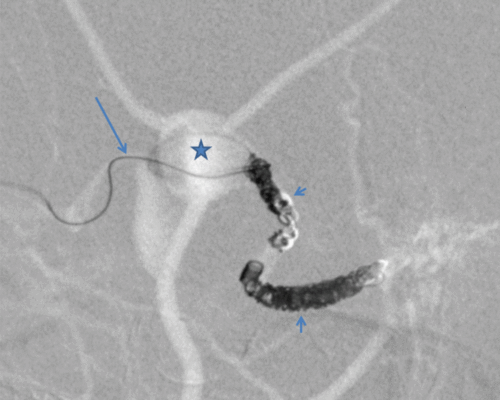Transjugular coiling of a Cognard IV dural arteriovenous fistula using a new monopolar detachable coil system through a flow-directed microcatheter
by Peter Voigt MD, Robert Jantschke, Ulf Nestler MD, Karl-Titus Hoffmann MD and Ulf Quäschling MD (Peter.Voigt@medizin.uni-leipzig.de)
Dear Editor,
Dural arteriovenous fistulas (dAVF) are shunts from meningeal arteries into venous sinuses and/or cortical veins [1]. DAVF can be classified according to their venous drainage pattern based on Cognard et al. and result in a bleeding risk of 40-65 % in the higher Cognard types III and IV [2]. The management of dAVF is challenging and includes various therapeutic approaches, such as endovascular treatment, surgery, or radiotherapy, and often requiring more than one intervention for a sufficient occlusion [3].
We treated a complex dAVF with multiple feeders from the middle meningeal artery and dural branches of the ophthalmic artery in a 76-year-old male patient by means of a new retrograde, transvenous endovascular approach that achieved the complete occlusion of the fistula in a single procedure. The draining vein of the dAVF (grade Cognard IV) showed two large aneurysmatic pouches in the middle cranial fossa with high risk of severe bleeding. The patient gave informed consent for the procedure and for the use of his data.
As a transarterial approach was considered not effective due to the configuration of the fistula, transvenous embolisation via the internal jugular vein using a flow-directed microcatheter with microwire guidance (MarathonTM catheter, MirageTM microwire, Medtronic, Minneapolis/US) was preferred. The rationale of this approach was to exploit the catheter’s flexible design to not cause artificial rupture of the venous aneurysms while passing them to reach the fistula.
However, so far none of the commercially available coil systems was suitable for usage via a flow-directed microcatheter. On the other hand, we were concerned to cause a rupture of the venous aneurysms or to be unable to reach the fistula point through any catheter stiffer than a very flexible flow-directed microcatheter. The solution to this problem came through a new monopolar detechable coil system (ED CoilTM, Kaneka, Tokyo/Japan) which is explicitly usable via flow-directed microcatheter. By using this system, we successfully occluded the fistula with a total of 20 detachable microcoils and avoided the intravenous application of glue which could have been unpredictable and harmfully distributed against the high arterial flow. Five days after the procedure, it would have been possible to discharge the patient without any further discomfort.
To the extent of our knowledge, this is the first report on occlusion of a Cognard IV fistula dAVF via a transvenous approach using the new ED CoilTM system. We consider this attempt safe and feasible. The unique capability of using the recently developed monopolar detachable ED CoilTM system through a flexible flow directed microcatheter opens up new perspectives in the transvenous endovascular treatment of deep dAVFs in higher Cognard grades with multiple feeders.
Figure 1 – Position of the microcatheter (long arrow) in the draining vein. A large venous aneurysm (star) has been passed successfully with the catheter. Multiple coils (short arrows) have already been placed to occlude the fistula.
If you would like to comment on this letter, please send your comments together with full contact data to office@european-radiology.org. Replies and comments will be reviewed by the Editorial Office and published on this website.

